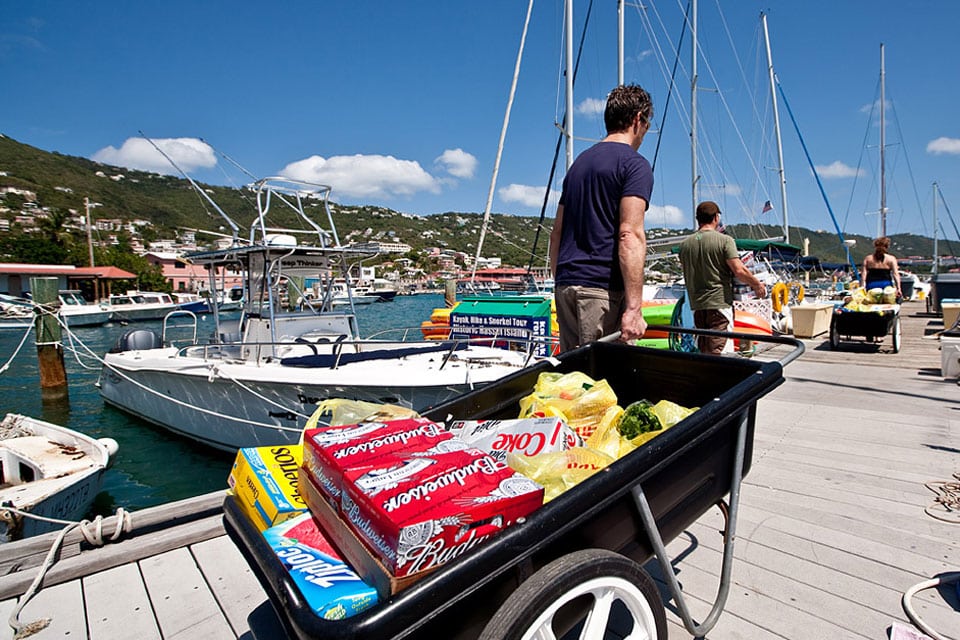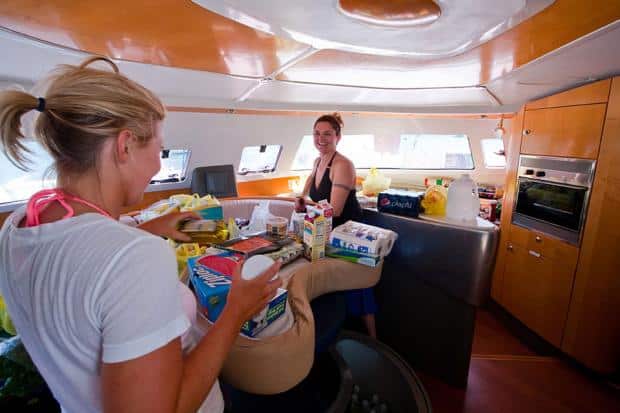
Provisioning for a Sailboat Charter
Set a budget. There are companies to match almost anyone’s budget. Compared with the cost of other types of vacations, such as skiing or staying at a resort, bareboat chartering is reasonable. Per person, crewed charters can run higher, but vacation brokers are highly skilled at meeting your price point, whatever it is.
Listed per-week prices are per sailboat, not per person. If you want to charter a 42-foot boat and the price is $4,300, it will be split among the number of charterers in your party. If you have six people in your party, that’s only about $720 per person—a bargain for a week of sailing in your dream cruising grounds. Additional boat expenses include fuel, water, and any government taxes and customs fees.
Your choice of sailboat is largely a matter of personal preference, as well as availability for the dates in question. Do you like speedy cruiser/racers or heavier-displacement cruising designs?
Maybe you’d like to try a catamaran. For chartering, cats have such advantages as shoal draft (good for shallow-water cruising grounds and for tucking into quiet coves for lunch and a swim) and an incredible amount of space for the length. The fact that they remain on a level plane is good if you have anyone in your crew who’s new to sailing. If you’re interested in trying out a catamaran but are unsure of yourself, take a captain along for a day or two to show you the ropes and help you get used to sailing a different design.
Study literature about the company’s fleet. Most brochures and/or websites have both photos and layout plans of each boat that’s available for charter. Consider how the layout and systems, both above and below decks, will work for the number of crew you’re sailing with and their physical abilities and comfort zones. Keep in mind that while it’s tempting to add bodies to lower costs, things go better if no one is forced to sleep in communal areas.
Most companies provide standard lists of equipment and amenities on each boat, including basic safety and electronics gear, dinghy (outboard rental may be extra), entertainment system, galley equipment, linens, and towels. Companies in tropical-reef areas usually provide snorkeling gear; in other areas, this varies. Such water toys as kayaks or stand-up paddleboards, for your amusement once the mother ship’s anchor is down, are generally available, sometimes for an extra charge. Ask for clarification if you’re in doubt; often, larger, more luxe boats have more for no extra charge than less expensive smaller ones.
Airfare isn’t included in the quoted boat-price expense. Many companies have affiliated travel agencies, often in-house, that will handle all your travel requirements, including hotels (if needed) at either end of the trip. Hotel costs also aren’t included in the weekly rate for the boat unless you book a special package deal. Using an in-house travel service is convenient, airfares can be lower than even those offered by discount-fare websites if companies book and hold blocks of seats ahead of time.

| |Photo by Amory Ross|
To the basic cost of the boat, travel, and accommodations, you must also add the cost of provisions. You can avail yourself of the online provisioning services the company offers, shop yourself after arrival, or bring groceries and beverages with you (easier if you’re driving to a domestic location). Remember that if you decide to provision on your own, you’re likely to spend the first day shopping instead of sailing.
Partial provisioning is also a good option—these starter packages provide enough supplies for the first couple of days, so you can get out on the water as soon as possible.
To take advantage of the best airline deals and to be certain that the boat you want will be available, plan your trip at least six months in advance of departure. During high season in prime charter areas, boats book quickly.
Once you’ve narrowed down the area you want to sail, visit the websites of the companies with fleets there. E-mail for literature and price lists. Visit sailing chat rooms and ask questions. Study company literature and compare notes. Follow up with phone calls. How well do company representatives answer your questions? How quickly does requested information arrive? This is a good initial indication of a company’s level of customer service.
You can also use boat shows to scope out charter companies; this is an excellent, face-to-face way to meet staff and get the feel for the company’s overall personality. Company employees are there specifically to talk to potential clients, to answer questions—and, of course, to book trips. Ask to see literature on fleets; they usually bring plenty of brochures and flyers with them to the shows. Many companies offer special boat-show discounts, so if you’ve winnowed your choices, a boat show is a good time to book your sailing vacation.
Contracts and Paperwork
Once you’ve decided to book, you’ll be required to send a deposit, then sign a contract. Contracts are designed for the protection of both the client and the company, and they also help prevent misunderstandings. They cover issues like liability, insurance, cancellation policy, and where you can and can’t sail (almost all prohibit night sailing unless there’s a professional skipper appointed by the company aboard).
One thing to ask, if it’s not stipulated in the contract or in writing elsewhere, is how the company compensates for days lost due to the boat having problems not caused by you. Most offer a credit toward a future charter or a refund for lost days. Contracts also generally specify the company’s policy regarding delivery of your boat to you. For example, if for some reason (such as unforeseen mechanical or other problems that can’t be fixed in time for your charter) the boat you specified isn’t available when you arrive, the company should provide a comparable or better boat than the one for which you originally contracted.
Now is also the time, if it isn’t stipulated in the contract, to clarify exactly what is—and isn’t—included in the quoted price of the boat. Some companies charge extra for fuel and water; others include it in the per-week rate. Policies also vary on charges for dinghies and outboards. If you don’t see it anywhere in print, ask.
The contract or other paperwork should also state the company’s support policy if something goes wrong with the boat. Companies in many areas provide chase boats that carry mechanics and spare parts; to service larger sailing areas, some companies have networks of personnel on islands or technicians who travel by commercial vessel to provide mechanical assistance. If you run into a problem after normal business hours, most companies have numbers you can call, either on a cell phone or on VHF.
After the initial deposit, you’ll send the company payments, usually in prearranged increments, before your charter. You’ll also be required to provide a refundable security deposit against any damage you or your crew may cause to the boat. After the charter, you’ll do a checkout with company staff, and if all’s well, your deposit will be refunded either on the spot or within 10 business days.
Many companies provide information about traveler’s medical insurance, which you should consider, especially if your own medical insurance doesn’t cover you outside the United States.
In the information the company provides, along with legal paperwork will also be helpful hints about what to bring, what not to bring, and background on the area you’ll visit. Some send cruising guides and notes in advance of the trip; others provide them on arrival. Company personnel can answer any questions you have after reading the material they provide.
What to Pack
F. Scott Farquharson of Dream Yacht Charter offers easy-to-follow steps on the item all companies declare is the second most important piece of advice for vacationing sailors: “Pack your bags,” he says. “Put them on the floor and look at them. Then unpack half of what you packed. Look at them again. Unpack half. Repeat, and you still will have too much. And no wheelie suitcases!”
Adds John Jacob of CYOA Yacht Charters: “Pack a carry-on with medications, personal items, a change of clothes, and a bathing suit. Be prepared for the airline to delay or even lose your baggage. Don’t pack anything valuable. You can purchase T-shirts, shorts, and bathing suits along the way.”
The point is that sailing is no formal affair. “Bring half as many clothes as you think you’ll need,” says Cindy Chestnut of Conch Charters, “and twice as much money. You’ll have a wonderful time.”
Click here to read more about how to plan a charter vacation.








